The BurundiNational Defence Force is the state military organisation responsible for the defence of Burundi.

The Armed Forces of Gabon or the Gabonese Defense and Security Forces is the national professional military of the Republic of Gabon, divided into the Army, Air Force, Navy, and a National Gendarmerie, consisting of about 5,000 personnel. The armed forces includes a well-trained, well-equipped 1,800-member guard that provides security for the President of Gabon.

A battalion is a military unit, typically consisting of 300 to 1,000 soldiers commanded by a lieutenant colonel, and subdivided into a number of companies. The typical battalion is built from three operational companies, one weapons company and one HQ company. In some countries, battalions are exclusively infantry, while in others battalions are unit-level organisations.
A company is a military unit, typically consisting of 100–250 soldiers and usually commanded by a major or a captain. Most companies are formed of three to seven platoons, although the exact number may vary by country, unit type, and structure.

Military ranks are a system of hierarchical relationships, within armed forces, police, intelligence agencies or other institutions organized along military lines. The military rank system defines dominance, authority, and responsibility in a military hierarchy. It incorporates the principles of exercising power and authority into the military chain of command—the succession of commanders superior to subordinates through which command is exercised. The military chain of command constructs an important component for organized collective action.
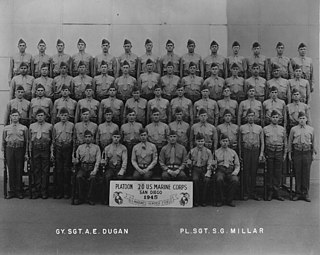
A platoon is a military unit typically composed of two to four squads, sections, or patrols. Platoon organization varies depending on the country and the branch, but a platoon can be composed of 20–50 troops, although specific platoons may range from 10 to 100 people. A platoon is typically the smallest military unit led by a commissioned officer. The platoon leader is usually a junior officer—a second or first lieutenant or an equivalent rank. The officer is usually assisted by a platoon sergeant.

The Republican Guard is part of the French National Gendarmerie. It is responsible for special security duties in the Paris area and for providing guards of honour at official ceremonies of the French Republic.
Sergeant is a rank in use by the armed forces of many countries. It is also a police rank in some police services. The alternative spelling, serjeant, is used in The Rifles and other units that draw their heritage from the British light infantry. Its origin is the Latin serviens, 'one who serves', through the Old French term serjant.

Military police (MP) are law enforcement agencies connected with, or part of, the military of a state. In wartime operations, the military police may support the main fighting force with force protection, convoy security, screening, rear reconnaissance, logistic traffic management, counterinsurgency, and detainee handling.
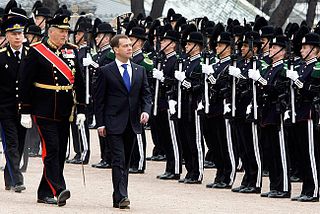
In some militaries, foot guards are senior infantry regiments. Foot guards are commonly responsible for guarding royal families or other state leaders, and they also often perform ceremonial duties accordingly, but at the same time are combat soldiers.
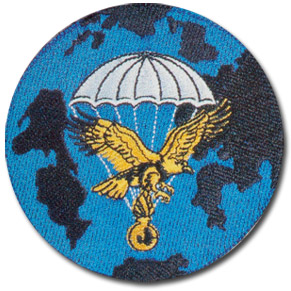
The Parachute Intervention Squadron of the National Gendarmerie was a parachute-trained tactical unit of the French Gendarmerie. The squadron was formed in 1984 with personnel from EPGM, a one-of-a-kind parachute squadron that had been created within the mobile gendarmerie in 1971 and was disestablished at that date. EPIGN, was based in Versailles-Satory with its sister unit GIGN. Besides its primary mission of providing heavy support and reinforcement to GIGN, EPIGN soon developed its own set of missions in the fields of protection and observation. It was finally absorbed, together with the "old" GIGN, into the newly reorganized GIGN in September 2007.

The 3rd United States Infantry Regiment is a regiment of the United States Army. It currently has three active battalions, and is readily identified by its nickname, The Old Guard, as well as Escort to the President. The regimental motto is Noli Me Tangere. The regiment is a major unit of the Military District of Washington (MDW).
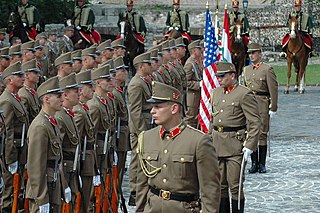
A guard of honour, honor guard or ceremonial guard, is a group of people, typically drawn from the military, appointed to perform ceremonial duties – for example, to receive or guard a head of state or other dignitaries, the fallen in war, or to attend at state ceremonials, especially funerals. In military weddings, especially those of commissioned officers, a guard, composed usually of service members of the same branch, form the sabre arch. In principle, any military unit could act as a guard of honour. However, in some countries, certain units are specially assigned to undertake guard of honour postings or other public duties. Republican guards, royal guards and foot guards frequently have ceremonial duties assigned to them.

The National Gendarmerie is one of two national law enforcement forces of France, along with the National Police. The Gendarmerie is a branch of the French Armed Forces placed under the jurisdiction of the Ministry of the Interior, with additional duties from the Ministry of Armed Forces. Its responsibilities include policing smaller towns, suburbs and rural areas, crowd and riot control, criminal investigation, including cybercrime. By contrast, the National Police is a civilian law enforcement agency that is in charge of policing cities and larger towns. Because of its military status, the Gendarmerie also fulfills a range of military and defence missions. The Gendarmerie has a strength of around 102,269 people.

The Royal Guard is an independent regiment of the Spanish Armed Forces that is dedicated to the protection of the King of Spain and members of the Spanish royal family. It currently has a strength of 1,500 troops. While the Guard participates in parades and other ceremonial events, it is a fully functional combat unit. Its members are recruited from the ranks of all three branches of the Spanish Armed Forces and receive the same combat training as regular soldiers.

The Mobile Gendarmerie (GM) is a subdivision of the French National Gendarmerie whose main mission is to maintain public order and general security. Contrary to the Departmental Gendarmerie, whose jurisdiction is limited to specific parts of the territory, the Mobile Gendarmerie can operate anywhere in France and even abroad as the Gendarmerie is a component of the French Armed Forces. Although the term "mobile" has been used at different times in the 19th century, the modern Mobile Gendarmerie was created in 1921.
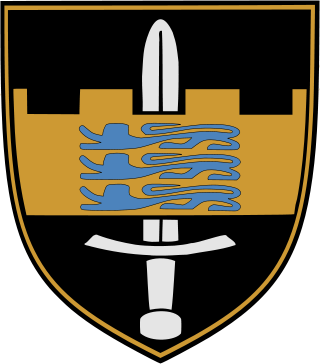
The Estonian Land Forces, unofficially referred to as the Estonian Army, is the name of the unified ground forces among the Estonian Defense Forces where it has an offensive military formation role. It is currently the largest Estonian military branch, with an average size of approximately 6,000 soldiers, conscripts, and officers during peacetime.
The Romanian Military Police is the military police of the Romanian Armed Forces. It was formed in 1990, immediately after the Romanian Revolution, although the Romanian Gendarmerie performed military police duties between 1850 and 1949.

The Gendarmery is the national gendarmerie force of Serbia, tasked with high-risk and specialized law enforcement duties. It is under the authority of the Police Directorate of the Serbian Police.

The National Armed Forces Staff Battalion is a specialized battalion of Latvian National Armed Forces. Its main tasks are to ensure the security of the NAF Joint Headquarters, providing secure and uninterrupted communications to NAF units and participating in military ceremonies. The Battalion is directly subordinate to the Commander of the Joint Headquarters.
















